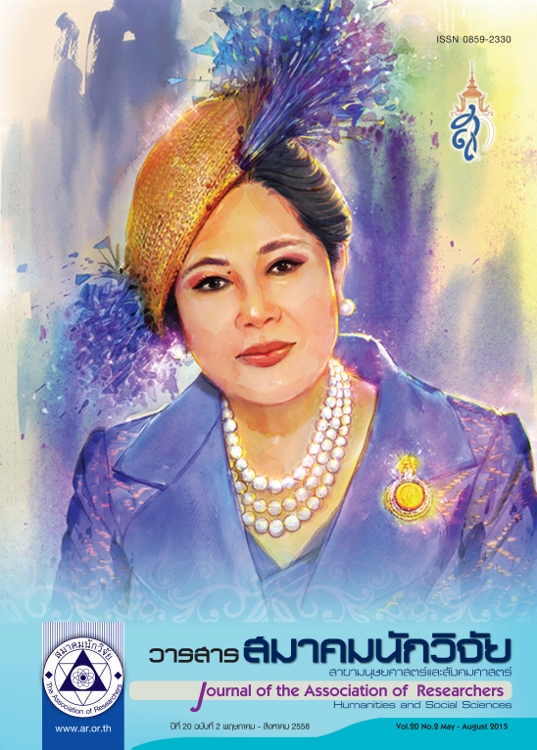Developing the Measurement Model of Entrepreneur’s Servant Leadership Style in Small and Medium Business in Chachoengsao Province
Main Article Content
Abstract
Research object was develop and test construct validity of servant leadership indicator in small and medium entrepreneur at Chachoengsao. Sampling is small and medium entrepreneur in Chachoengsao 450 subject. Collection data by questionnaire 5 rating scale. Analysis by secondary confirms factor analysis. Result is the indicator of servant leadership have 5 factor was esteem of others, development of others, creating community and expression of moral. The model is harmony with the empirical data.
Article Details
Section
Research Articles
บทความที่ปรากฏในวารสารนี้ เป็นความรับผิดชอบของผู้เขียน ซึ่งสมาคมนักวิจัยไม่จำเป็นต้องเห็นด้วยเสมอไป การนำเสนอผลงานวิจัยและบทความในวารสารนี้ไปเผยแพร่สามารถกระทำได้ โดยระบุแหล่งอ้างอิงจาก "วารสารสมาคมนักวิจัย"
References
สร้อยตระกูล อรรถมานะ (2543). พฤติกรรมองค์การ: ทฤษฎีและการประยุกต์. กรุงเทพฯ. สำนักพิมพ์แห่งมหาวิทยาลัย ธรรมศาสตร์
จตุรภัทร วงศ์สิริสถาพร และคณะ (2557). การจัดการความรู้ที่ส่งผลต่อทุนมนุษย์ของผู้ผลิตเซรามิกขนาดกลาง และ ขนาดย่อม ในจังหวัดภาคเหนือตอนบนของประเทศไทย. วารสารสมาคมนักวิจัย. 19(2): 15-36.
ไทยตำบล ดอทคอม (2554) ศูนย์รวมข้อมูลสถานประกอบการ ขนาดกลางและขนาดเล็กของประเทศไทย สืบค้นเมื่อ 4 ธันวาคม 2554 จาก http://www.thaitambon.com/tambon/tsmesrc.asp? sSearch=&FL=sName&cSmeType=1&sprovcode=24&ORDER=sName&AD=ASC&search=%A4%E9%B9%CB%D2+%5BSea rch%5D
สุวรรณิน คณานุวัฒน์ (2557). การบริหารจัดการกลยุทธ์เพื่อสร้างขีดความสามารถในการแข่งขัน ของบริษัท การบินไทย จำกัด (มหาชน). วารสารสมาคมนักวิจัย. 19(2): 45-67.
Anderson, P.K., (2006). A correlation analysis of servant leadership and job satisfaction in a religious educational organization. Dissertation, Ed.D.University of Phoenix.
Covey, S.R. (2002). Servant leadership: A journey in to the nature of legitimate power and greatness. Mahwah, NJ: Paulist.
Daft, R, L. (2002). Leadership Theory and Practice. Forth Worth, TX: The Dryden Press.
Donato, J. J. (2006). Grace and faith in action: Portraits of ongoing priestly formation. .Dissertation Abstracts International, 67(02), 240. (UMI No. 3204069)
Dubrin, A. J. (1973). Fundamentals of organizational behavior. New York: Pergamon press.
Greenleaf, R (1977). Servant Leadership. Mahwah, NJ: Paulist Press.
Greenleaf, R. (2002). The Servant Leadership: A Journey Onto the Nature of Legitimate Power and Greatness. 25th ed. New Jersey: Paulist Press.
Goldstein IL & Ford J,K. (2002). Training in Organizations. Belmont, CA:Wadsworth. 4th ed.
Hunter, J. C. (2004). The World’s Most Powerful Leadership Principle. New York: Crown business.
Laub, A.J (1999) Development of the organizational leadership Assessment (OLA) instrument. Dissertation, Ed.D. Florida Atlantic University Boca Raton, Florida
Lambert, W. E. (2004). Servant Leadership Qualities of Principals, Organizational Climate, and Student Achievement: A Correlational Study. Dissertation, Ed.D. Nova Southeastern University.
Miears, L.D (2004). Servant-leadership and job satisfaction: A correlational study in Texas education agency region x public schools. Retrieved July 26, 2009 From http://www.slideshare.net/Nathan Eva/servant- leadership-and-structure
Irving, J. A. (2005). Servant Leadership and the Effectiveness of Teams. Retrieved July 26, 2009, from http://www.bethel.edu/~irvjus/PDF/Irving, JustinRegentUniversity_final.pdf
Nelson, S., & Thompson, G. (2005). Barriers perceived by administrators and faculty regarding the use of distance education technologies in pre-service programs for secondary agricultural education teachers. Journal of Agricultural Education, 46(4), 36-48.
Walker, P. D. (1997). A case study of servant leadership. Unpublished manuscript, The University of San Francisco.
Yulk, G. (2000) Influence behavior questionnaire. Upper Saddle River, NJ: Prentice-Hall.
จตุรภัทร วงศ์สิริสถาพร และคณะ (2557). การจัดการความรู้ที่ส่งผลต่อทุนมนุษย์ของผู้ผลิตเซรามิกขนาดกลาง และ ขนาดย่อม ในจังหวัดภาคเหนือตอนบนของประเทศไทย. วารสารสมาคมนักวิจัย. 19(2): 15-36.
ไทยตำบล ดอทคอม (2554) ศูนย์รวมข้อมูลสถานประกอบการ ขนาดกลางและขนาดเล็กของประเทศไทย สืบค้นเมื่อ 4 ธันวาคม 2554 จาก http://www.thaitambon.com/tambon/tsmesrc.asp? sSearch=&FL=sName&cSmeType=1&sprovcode=24&ORDER=sName&AD=ASC&search=%A4%E9%B9%CB%D2+%5BSea rch%5D
สุวรรณิน คณานุวัฒน์ (2557). การบริหารจัดการกลยุทธ์เพื่อสร้างขีดความสามารถในการแข่งขัน ของบริษัท การบินไทย จำกัด (มหาชน). วารสารสมาคมนักวิจัย. 19(2): 45-67.
Anderson, P.K., (2006). A correlation analysis of servant leadership and job satisfaction in a religious educational organization. Dissertation, Ed.D.University of Phoenix.
Covey, S.R. (2002). Servant leadership: A journey in to the nature of legitimate power and greatness. Mahwah, NJ: Paulist.
Daft, R, L. (2002). Leadership Theory and Practice. Forth Worth, TX: The Dryden Press.
Donato, J. J. (2006). Grace and faith in action: Portraits of ongoing priestly formation. .Dissertation Abstracts International, 67(02), 240. (UMI No. 3204069)
Dubrin, A. J. (1973). Fundamentals of organizational behavior. New York: Pergamon press.
Greenleaf, R (1977). Servant Leadership. Mahwah, NJ: Paulist Press.
Greenleaf, R. (2002). The Servant Leadership: A Journey Onto the Nature of Legitimate Power and Greatness. 25th ed. New Jersey: Paulist Press.
Goldstein IL & Ford J,K. (2002). Training in Organizations. Belmont, CA:Wadsworth. 4th ed.
Hunter, J. C. (2004). The World’s Most Powerful Leadership Principle. New York: Crown business.
Laub, A.J (1999) Development of the organizational leadership Assessment (OLA) instrument. Dissertation, Ed.D. Florida Atlantic University Boca Raton, Florida
Lambert, W. E. (2004). Servant Leadership Qualities of Principals, Organizational Climate, and Student Achievement: A Correlational Study. Dissertation, Ed.D. Nova Southeastern University.
Miears, L.D (2004). Servant-leadership and job satisfaction: A correlational study in Texas education agency region x public schools. Retrieved July 26, 2009 From http://www.slideshare.net/Nathan Eva/servant- leadership-and-structure
Irving, J. A. (2005). Servant Leadership and the Effectiveness of Teams. Retrieved July 26, 2009, from http://www.bethel.edu/~irvjus/PDF/Irving, JustinRegentUniversity_final.pdf
Nelson, S., & Thompson, G. (2005). Barriers perceived by administrators and faculty regarding the use of distance education technologies in pre-service programs for secondary agricultural education teachers. Journal of Agricultural Education, 46(4), 36-48.
Walker, P. D. (1997). A case study of servant leadership. Unpublished manuscript, The University of San Francisco.
Yulk, G. (2000) Influence behavior questionnaire. Upper Saddle River, NJ: Prentice-Hall.


